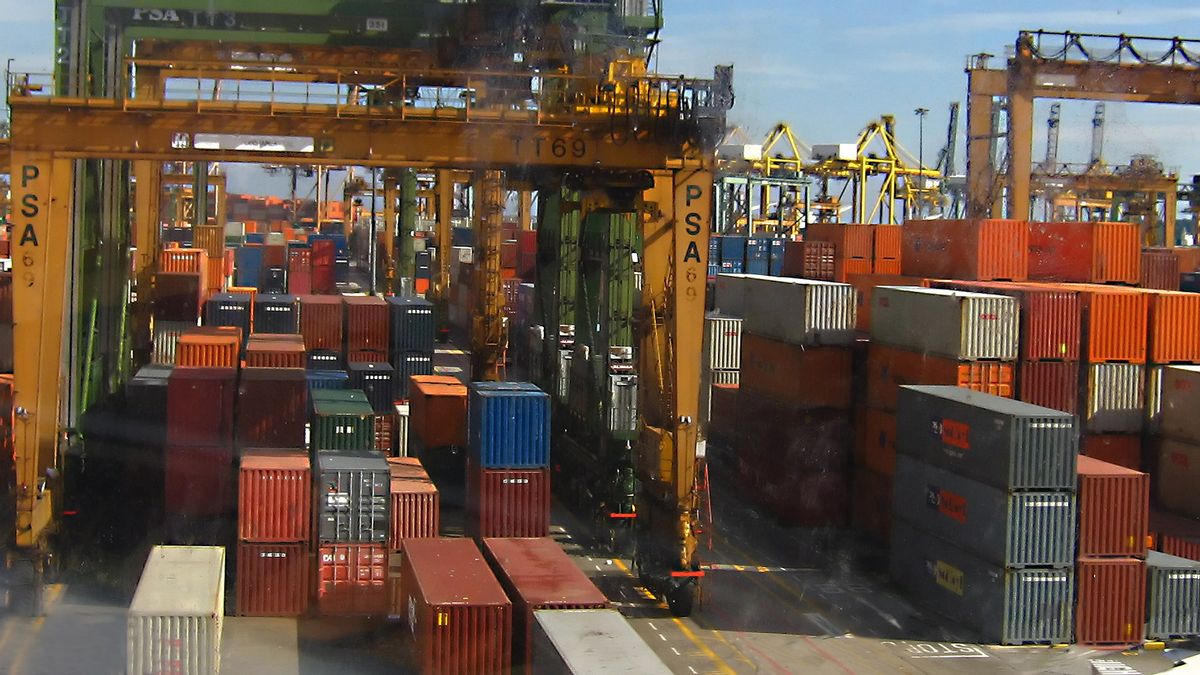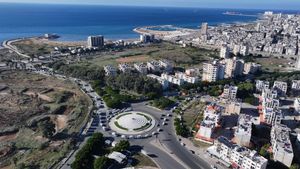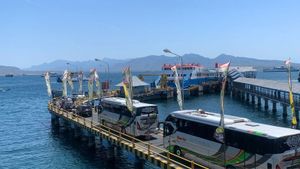JAKARTA - The Jakarta International Container Terminal (JICT) is an important element for the Indonesian economy. JICT's role in export-import activities cannot be underestimated. In 2017 JICT was developed to become the largest container terminal in Indonesia. One day, there are 12 thousand container trucks working at JICT.
Based on history, JICT cannot be separated from the role of Perum Pelabuhan II, which at that time managed the government-owned port. Perum Pelabuhan II, which was named PT Pelabuhan Indonesia II / Pelindo II, has operated 12 ports in Indonesia. Launching the Binus page, apart from managing the port, Pelindo II then has several subsidiary companies.
As a result, JICT is one of the four export-import container service terminals owned by Pelindo II. The four terminals include JICT, Koja Container Terminal (TPK Koja), Mustika Alam Lestari (MAL), and Multi Terminal Indonesia (MTI).
After that, since it was first established, JICT has continued to make achievements. It is noted that more than 25 countries have used the integrated JICT services by more than 20 companies to date.
The advantage is that JICT can at one time carry out activities freely, from unloading containers from ships to containers leaving the port area (gate out). Moreover, this is also supported by the total area of JICT which reaches a total area of 100 hectares.
JICT can serve 35-40 vessels each week. Plus, with the presence of a port integration system for 24 hours. This system has enabled JICT to make a lot of history in the national economy.
For one thing, JICT made history as a prime port that produces 27-30 Mph - movements per hour - to be able to handle one ship. JICT's success in handling this one vessel was proven when the largest vessel CMA CGM Otello, which incidentally belongs to a French shipping company, anchored at JICT's container port in 2017.
In line with the visit of the CMA CGM ship, JICT then opened a new service for the Tanjung Priok Port route to the West Coast (Los Angeles & Oakland), United States. The service is intended to optimize the productivity of exporters and importers in Indonesia. All of this is for the sake of turning the wheels of the nation's economy, especially giving life to its workers.
"For the workers, PT Jakarta International Container Terminal (JICT), is not just a place to earn a living. The largest container port in Indonesia has been regarded as a symbol of the sovereignty and also the muruah of the Indonesian nation. Because of that, they feel they have a big responsibility to guard the gates of this sovereignty from the touch of those who reap profits, "wrote Md Aminuddin and Ahmad Khoirul Fata in the book Against Global Conspiracy in Jakarta Bay (2018).
Starting from the Port of Tanjung PriokThe existence of JICT almost certainly would not have appeared on the national map if the Dutch colonial government did not immediately move the main port to Tanjung Priok Port. Thanks to the move from Sunda Kelapa Port to Tanjung Priok, the northern area of Jakarta became the pulse of Indonesia's economy at that time
The construction of the Tanjung Priok Port in 1877 became the main milestone. The reason for the construction of the Tanjung Priok Port is because the Sunda Kelapa Port is experiencing silting. The Company is dizzy. Steam ships were no longer able to lean there, so those who sailed from abroad had to lean far on the shore.
As a result, loading and unloading of goods takes a very long time because they have to be lifted by boat first. As quoted by Alwi Shahab in the book Waktu Holland Drunk was Born Batavia (2013), because of all the existing problems, the Company then decided to move the Sunda Kelapa Harbor.
And the Tanjung Priok area was chosen as its replacement. Even though the distance was quite far, about 7 kilometers, the Company felt it was the best option because the Suez Canal, which could shorten ship travel, was opened in 1869.
“In 1868, when the Suez Canal opened, which shortened ocean voyages from Europe to Asia as well as the emergence of steamships, had an effect on Batavia. The city that was built by Jan Pieterszoon Coen was then crowded with immigrants from Europe. Likewise with ocean ships loading and unloading. The construction of Tanjung Priok Port coincided with the Singapore port built by Raffles in 1819, "said one of the important figures in the writing of the history of Jakarta, Alwi Shahab.
The emergence of the Tanjung Priok port then occupied a major position in West Java's import-export affairs. It was so busy that the tonnage of the ships had greatly increased over the years. To that end, the Port of Tanjung Priok was expanded again in 1912. This was because almost 200 ships were waiting for their turn to dock. In more detail, we have reviewed in the article "The importance of Tanjung Priok Harbor for Batavia".
"Regarding exports, almost all shipments of Javanese tea and quinine products take place at this port. As for rubber and vegetable oil processing, Tanjung Priok also occupies the first place among other Java ports. The transfer of loads of several products, including Bangka tin, pepper and several wood products from the Outer islands, also took place here, "wrote Dr. J. Stroomberg in the book Dutch East Indies 1930 (2018).
The condition of Tanjung Priok as the pulse in north Jakarta is still going on to this day. This existence is supported by the presence of the largest container terminal in Indonesia, JICT. Because of this, Muruah Priok as an important area in the north of Jakarta is well maintained. This is because there is a large circulation of economic money present at the Port of Tanjung Priok and JICT.
The English, Chinese, Japanese, Arabic, and French versions are automatically generated by the AI. So there may still be inaccuracies in translating, please always see Indonesian as our main language. (system supported by DigitalSiber.id)









